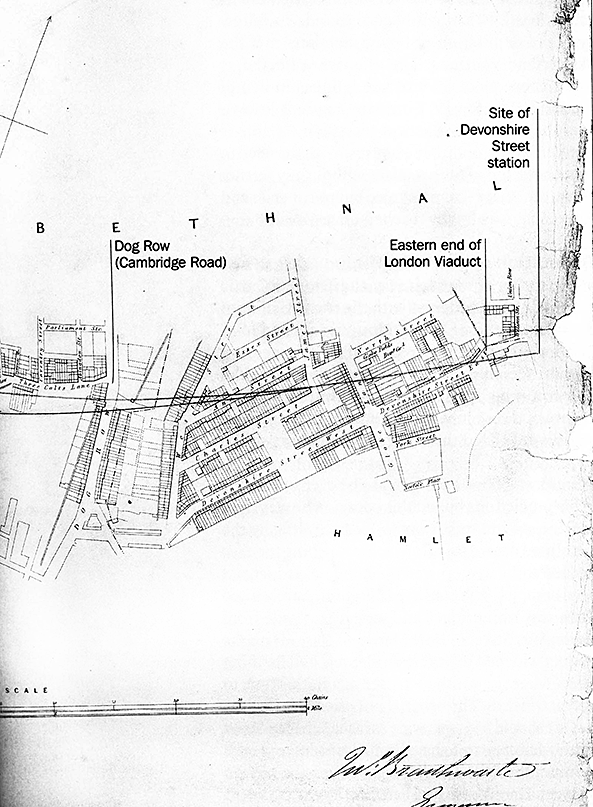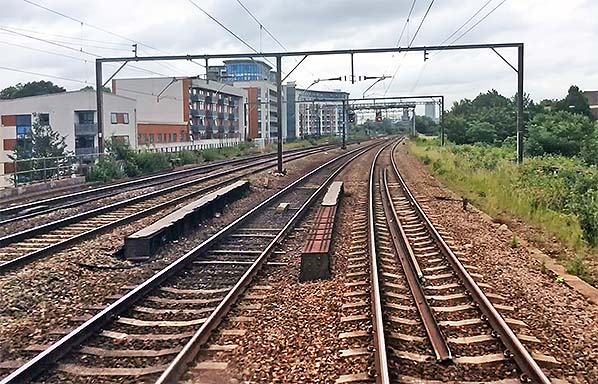Notes: The Eastern Counties Railway was incorporated in 1836 to link London with Ipswich via Colchester, and then extend to Norwich and Yarmouth. At that time this was the longest line sanctioned by a single Act of Parliament with a total length of 126 miles.
Construction began in late March 1837 on the first nine miles at the London end. John Braithwaite was the as engineer and the gauge was set at 5ft compared to the national standard of 4ft 8½in. Progress east of Stratford was relatively easy as the land was largely arable. West of Stratford, the line had to cross the unstable Bow Marshes and after that the built-up nature of the area meant that the railway had to be built on expensive viaducts. The London Viaduct carried the line from Devonshire Street, Mile End to the terminus at Shoreditch, a length of 2.300yd.
The viaduct was to be built in stages, the first stage running from the embankment which ended at the junction of Morpeth Street and Devonshire Street to Cambridge Road where a temporary station would be built to allow the line to be opened between there and Romford. Encouraged by the speedy construction of the line between Mile End and Romford, the ECR committee decided in August 1838 that they would abandon plans for a temporary station and push on towards Shoreditch in order to open the completed line at the earliest opportunity. The contract for the first section was awarded to Thomas Curtis & Sons from Stratford.
By January 1839 such good progress had been made at the Romford end that the company decided that all four sections of the viaduct should be constructed simultaneously in an effort to reach Shoreditch and Romford at the same time. The enthusiasm was dampened when an unexpected shortage of funds led to the contracts for the viaduct being suspended on 30 March 1839, forcing the company to revert to is earlier plan for a temporary station at Cambridge Road. However as three of the cast-iron bridge on the viaduct had not been completed there was yet another change of plan when on 7 May 1839 the directors agreed to build a temporary station at Devonshire Street to allow a service to Romford to begin.
The exact position of the temporary station is not identified in any surviving ECR documents but a deposited plan (below - click on plan to see a larger version) showing the deviation in the route of the ECR between Mile End and the Shoreditch indicates that the site of the station was at the start of the embankment immediately east of William Street and to the north of Devonshire Street East.

Devonshire Street station was quickly built on the embankment. A contemporary drawing of the rear platform elevation (reproduced below) shows it to be single storey and of timber construction with an open stairway down to road level. It is assumed to have had two facing platforms. The station was officially opened on 18 June 1839 with a passenger service to Romford along the double-track line starting two days later.
The opening of the line was reported in the Civil Engineer & Architects Journal: ‘This railway was opened on Tuesday, the 18th ultimo. A large concourse of persons assembled at the temporary station, Devonshire Street, Mile End to witness the departure of the first train on this line of the railroad.’ The report continues, ‘The portion of the railway now open to the public terminates at Barrack Lane, immediately adjacent to the town of Romford; the total distance is about ten miles and a half which the trains will accomplish in less than half an hour. The whole of the gradients are favourable. It may not be generally known that the line is laid down to a 5 feet gauge, which without greatly increasing the weight of the engines, gives them great mechanical advantages which they have not failed to turn to account. The engineer to the line is Mr. Braithwaite, to whom much praise is due for the generally efficient manner in which the works and engineering difficulties (not a few) have been executed.’
Another contemporary report on the opening of the line stated: ‘The two-track railway opened on 20 June 1839 from a temporary terminus at Devonshire Street in Mile End, Middlesex, as far as Romford in Essex. On opening day, two trains topped and tailed by locomotives proceeded along the line watched by crowds of people. Guests of the company enjoyed a sumptuous banquet at Romford enlivened by the sound of cannon and the band of the Coldstream Guards.’

The construction of a second temporary station at Brick Lane was considered in March 1840 but it was decided instead to open the line to Shoreditch as soon as possible. On 1 July 1840 the ECR opened an extension at the London end to its permanent terminus at Shoreditch (renamed Bishopsgate in 1846). Although Shoreditch had opened, Devonshire Street station remained open as an intermediate station. It was still in use on 15 November 1840 when it is mentioned in an accident report. A minute of the ECR committee on 25 November 1840 records that Bow Station was to be closed and Devonshire Street was also to close later.
On 2 March 1841 the ECR committee discussed removing Devonshire Street station to Dog Row (near Cambridge Road, now Cambridge Heath Road) which refers to the site of the soon to be opened Mile End station. The committee was told that an engineer would report on the probable cost the following week. On 11 April 1841 it is recorded that a drunk fell off the platform. On 29 April 1841 the committee minutes state, 'Remove such part of Devonshire St. Station as needed to establish station at Cambridge Rd.; additional work to be done by tender at least possible expense.'
The Railway Times for 8 May 1841 reports: ‘An Eastern Counties train which ought to have left Shoreditch station at 10 o’clock on Sunday morning 15th November ....... It proceeded with its usual speed to Devonshire Street station, a distance of one mile and a half when it stopped about one minute and then left for Bow station, about a mile further on, where it stopped at 13 minutes past 10 o’clock. The train, from the slippery state of the rails, overshot the station about 20 or 30 yards but having only one passenger to leave there did not put back.’
Devonshire Street did not appear in Bradshaw and was probably replaced by Mile End or closed shortly after Mile End opened around the end of May 1841. It is unlikely that Mile End and Devonshire Street would have been open at the same time as the stations were very close to each other.
Surviving Eastern Counties Railway minutes from the period to 1845 mention several proposals for use of the by-now-closed Devonshire Street station, including relocating it, or parts of it, elsewhere. This implies that only part of the station (or maybe none of it) was used at Mile End.
During this period there were numerous complaints about poor and insecure goods facilities at Colchester. On 11 April 1845 a request by a coal merchant. H P Burt, to use the original Devonshire Street terminus for the sale of coal was refused outright, probably because the following month it was announced a relocation of the station to Colchester for use as a goods depot. From this point on, the situation becomes vague as it is unclear if the entire station was to be dismantled and relocated or if merely certain salvaged materials were to be reused. The Eastern Counties Railway made no further mention of the matter but the Great Eastern Railway did, albeit obliquely. The complaints regarding Colchester's goods facilities seem to have subsided by the mid 1860s as a goods depot had by then appeared behind Colchester station's up platform and by this time was in need of repairs. It is thus highly likely that this goods depot was the structure, or materials salvaged from it, transferred from Devonshire Street. Colchester station saw a number of alterations in the second half of the nineteenth century, some major, and in 1899 a new transfer shed was constructed on the north (down) side of the line. On this basis it can be assumed the ex-Devonshire Street structure finally disappeared in 1899.
Click here for a rear cab view video Mile End - Liverpool made by Nick Belton in June 2017. The sites of Devonshire Street & Mile End goods yard, Devonshire Street station, Globe Road & Devonshire Street station, Mile End station and Bishopsgate Low Level station are all seen.
Sources:
- Minutes, records and other documents of the Eastern Counties Railway & Great Eastern Railway
- Great Eastern Society Journal 166 (April 2016). Shoreditch - The London terminus of the Eastern Counties Railway. A fresh look at its history. Part 1
See Also: Mile End, Globe Road & Devonshire Street, Coborn Road (2nd) & Coborn Road (1st) |






 Home Page
Home Page